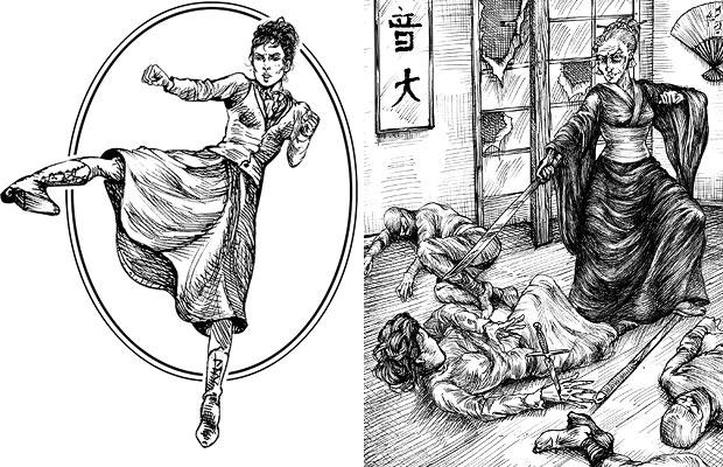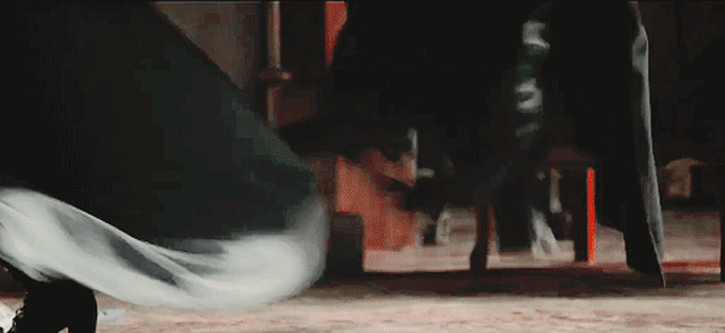Female Warriors and 'The Oriental'.
While it’s reasonable for one to assume that the opportunity to study martial arts is a privilege of the noble class, these women's new fighting abilities are only tolerated by the nobility as a necessary evil. Even under the threat of attacking zombies, women are still held to a particular level of decorum and manner. This complex attitude towards female warriors underscores the prominence of gender inequality in the film.
Flawed Depiction of China-Western Relations.
Great Britain, along with many other European countries and westernized Asian countries, forced the historically self-sufficient agricultural empire to open its gate and pushed China into the trend of global trade. The weakened Chinese empire had no choice but giving away its land and sovereignty after several unsuccessful attempts at fighting back.
Foreign missionaries and businessmen swarmed into China to spread "civilization" and seek their fortunes. Encounters with Chinese culture were usually described as modern civilization converting the primitive, mysterious, and incompetent doctrines of the Chinese. If we keep this historical background in mind, the appreciation of what is referred to in the film as "Oriental culture" seems pretty out of place.
These two paradoxes--Orientalism and female empowerment in the early 19th century--both have the potential to escalate the original story to a deeper level of inquiry into gender and cultural privilege. However, the movie's directors don't seem to bother. Instead, Pride and Prejudice and Zombies easily focuses on dramatic battle scenes, while leaving these two threads unresolved.
Unpacking the Zombie Concept.
- Zombie—an undead being created through the reanimation of a human corpse. (Wikipedia) Originated in Haitian Vodou, zonbi can mean several different beings, from a stolen soul to a spirit receptacle. (Kordas) However, since its first appearance in American pop culture in the 1932 movie White Zombie, “zombie” (note the difference in spelling with the original Haitian zonbi) has been depicted as a “reanimated, mindless, soulless corpse taken from its grave to serve the master who had awakened it.” (Kordas) The social and cultural representation of the zombie in the United States is usually strongly linked with social groups that are feared or considered threats by White, middle-class Americans, examples vary from immigrants of color to “modern, strong women.”
- Pride and Prejudice—a novel by Jane Austen. It follows the story of its main character, Elizabeth Bennett, the second of five daughters of an early 19th century English country gentleman, Mr. Bennett. The novel discusses multiple themes, including marriage, social class, morality, and identity in the society of landed gentry of the British Regency. (Wikipedia)
With these two key terms defined, we can now start unpacking some plots of the movie and try to spice it up (or nerd it up) with a hint of zombies.
Why Fear Zombies At All?
On one hand, the distinction between human and zombie, us and them, is clear from the very beginning. Whoever is found out to be a zombie will be outcast by the aristocratic community, just like how the chosen one is stoned by the villagers in Shirley Jackson’s short story The Lottery. On the other hand, no one is immune to the zombie plague.
Even main characters like Jane, Elizabeth’s own sister, have the possibility of being infected. When the warrior faces the fact that she might need to fight her beloved sister, her faith shakes. Elizabeth tries to protect her sister from Mr. Darcy’s suspicion that she’s bitten by a zombie. This is the director's opportunity to push the film's moral dilemma to the max. This is the moment when pride and prejudice can be penetrated and broken. But then again, everyone’s too busy fighting zombies with dazzling weaponry and flamboyant moves to really engage in these philosophical questions.
Overall, I’ll say the movie is TOLERABLE. The film is tolerable as a product of pop culture, aka mass “pride” and “prejudice”. The director has no intention to join Jane Austen for the timeless discussion on all those great moral themes. In fact, Jane Austen, in this case, is like a zombie, appropriated by pop culture makers and positioned as a source of entertainment.
As for all my disappointment mentioned above, forget about it. I blame it on my sociology-anthropology student mindset that complicates everything and makes me one of those obnoxious zombies.


 RSS Feed
RSS Feed